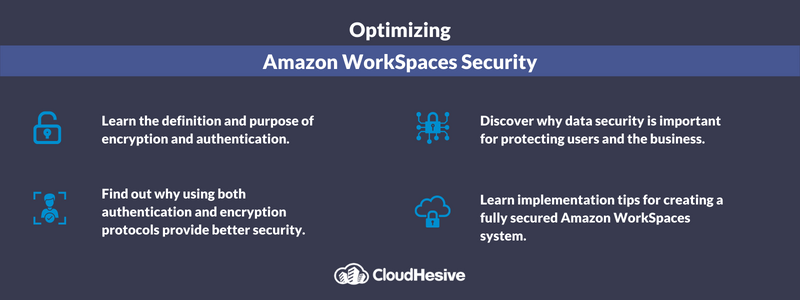Essential elements for Amazon WorkSpaces security
Network security is an ever evolving and complex system made up of encryption, authentication, gateways, endpoints, data at rest, and data in transit. All are meant to secure business data from unauthorized access. Business data is key to success in the modern business world and includes customer information, financial details, marketing information, and analytics that help inform business decisions.
Cloud-based Amazon Web Services (AWS) systems are serious when it comes to securing assets. However, the AWS security model shares security responsibilities between the AWS cloud system and the participating business. When planning an Amazon WorkSpaces strategy, include the business side approach to securing all business content placed within the AWS cloud infrastructure.

This guide provides information on the critical nature of data security, and how encryption and authentication are part of a secured Amazon WorkSpaces implementation.
Encryption and its purpose
Encryption is part of the method of security using cryptography. When using encryption, all code and data are translated or converted into unreadable text strings. Encrypted data becomes ciphertext when encrypted and is not human- or machine-readable. The key to using encrypted text becomes the decryption key. Only the decryption key understands the meaning of the encrypted data, so for a computer system to use the data in the encrypted information, it must have the decryption key.
The purpose of using encryption is to secure data or other business information while in transit and at rest. Encryption ensures that data can’t be intercepted and understood during communication between systems. Without the decryption key, the encrypted data is useless.
Authentication and its purpose
Authentication is a method of allowing access to a system by user authentication. Authentication systems use tokens to verify users’ access and log them into the network system with access to data or items based on their credentials. For example, when logging into a device on a network, systems like AWS use the HTTPS protocol to pass tokens and transmit credentials securely.
The purpose of authentication is to verify the user has the authorization to access the network. By using authentication, systems like Amazon WorkSpaces ensure access is granted to only those with the appropriate credentials.
Data security – the lifeblood of a modern business
The value of business data in today’s business environment is greater than it’s ever been, and it’s only going to gain value. Why? Because all business and customer data is saved, reused for analytics, and retained in databases.
Poor data security impacts business profits significantly. A data breach involves losing business trade secrets, intellectual property, and financial information for the business and its customers. Trustworthiness is at a premium, and 75% of consumers report they will not use companies they don’t trust to protect their data.
There are also government compliance standards and hefty negative financial impacts when a data breach occurs. Don’t let it happen to you; secure data using encryption and authentication methods from its creation, during use and when data is transferred to another system, as well as when it is stored in a database.
When working with Amazon WorkSpaces, AWS provides infrastructure security but the business must share in the security responsibility by securing business data and device access, use, and connectivity to the network system.
Amazon WorkSpaces implementation tips for security success
As mentioned, a business using Amazon WorkSpaces shares security responsibilities with AWS. Within the shared security model, the business must secure all content hosted on the AWS infrastructure. Business content includes security configuration and the associated management tasks associated with Amazon WorkSpaces and any other AWS services used.
Tips for securing an Amazon WorkSpaces system include:
- Setting up individual user accounts using AWS Identify and Access Management.
- Securing all data by:
- Using multifactor authentication for every account.
- Using SSL/TLS 1.2 for communication with AWS resources.
- Configuring API and user activity monitoring using CloudTrail.
- Using AWS encryption solutions with default security controls.
- Using the advanced managed security service, Amazon Macie, to secure personal data stored in the system.
- Using FIPS 140-2 or above to validate cryptographic modules accessed via command line interfaces or APS.
- Confirming security services meet compliance standards.
- Never storing confidential or sensitive information in free-form fields.
- Not including URLs to an external server with credential or authentication information stored in the message.
Other tips to consider include:
- Turning on Virtual Private Cloud (VPC) flow logging.
- Activating multifactor authentication for the root account.
- Creating security groups of users to control access by group.
- Implementing zero trust security to control application access.
- Using bring-your-own-device (BYOD) adaptive security in place of VPN.
- Continuously monitoring API endpoint activity.
Securing a network even with a partner sharing the burden is a complex and ever evolving task. Make use of the latest encryption protocols to keep data safe throughout its life cycle. Pair encryption methods with strong authentication protocols to control network access. Control and secure access, but also remember to track. Logs and audit trails let you know when unauthorized users are trying to attack the system. Be prepared and track wherever possible.
Amazon WorkSpaces offers an effective, secure, and managed method of providing access to remote employees and enabling a flexible workforce. Make sure the system is secured at the business content level within the AWS infrastructure and meets all relevant compliance requirements based on where the business is active.
Need help creating a secure Amazon WorkSpaces network? CloudHesive provides support and deep expertise in using the AWS cloud for the best business advantage. As an Amazon Managed Services partner, and Amazon Premier Partner, CloudHesive helps businesses take full advantage of all the features AWS offers, including Amazon WorkSpaces implementation and management. See what other customers have to say in case studies available from CloudHesive.



